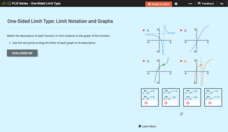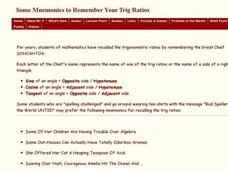CK-12 Foundation
One-Sided Limit Type: Limit Notation and Graphs
A one-sided limit is no less important than a two-sided limit. Young mathematicians use an interactive to match limit notation to graphs. The exercise requires interpreting how one-sided limits connect to features of graphs.
CK-12 Foundation
Infinite Limit Type: Asymptotes and End Behavior Question
There are an infinite number of reasons to use the resource. Scholars drag vertical and horizontal lines to the graph of a rational function to identify all asymptotes. They investigate the connection between asymptotes and limits to...
CK-12 Foundation
Even and Odd Functions and Function Symmetry: Even and Odd Functions (Symmetry)
Even money states that the resource is good to use. Scholars manipulate an interactive to adjust the portion of a graph to the left of the y-axis. The interactive allows them to switch between even and odd modes that show the right side...
Curated OER
Hands On: Model Finding the Mean
In this data instructional activity, 5th graders use counters to model finding the mean in 6 word problems. They work with 6 sets of numbers which include fractions.
Curated OER
Food for Spaceflight
When astronauts get hungry in outer space, they can't just call and have a pizza delivered. In order to gain an appreciation for the challenges associated with space travel, young learners are given the task of selecting, testing, and...
Curated OER
The Verbs Have, Do, and Go
Using this simple activity could be a good way for your youngsters to practice using the verbs have, do, and go. By filling in the answers to the 12 questions, learners identify the correct verb.
Teach Engineering
Ampere's Law
Help your class find the the magnetic field of a toroid, a solenoid bent into a circle with an activity that allows the class to see how a loop of wire carrying an electrical charge behaves much like a magnet. The resource provides the...
Cmassengale
Photosynthesis Diagrams Worksheet
Help young botanists get to the root of photosynthesis with this series of worksheets. By completing these diagrams, students demonstrate their understanding of the biological structures and chemical reactions that make this amazing...
Curated OER
MATH IS BEAUTIFUL: More And Less
Students use tempura paints and mixing techniques to explore the mathematical concept of ratios in this cross-curricular late-elementary/ealy middle level Math lesson plan. A homework assignment is included.
Curated OER
Math: Am I Prime?
Seventh graders determine the difference between prime and composite numbers. On a Website, they discover a method to identify all the prime numbers up to 100 and also complete several online activities. Once they have discussed the...
Super Teacher Worksheets
Number Patterns
Pattern recognition is an essential step in the development of young mathematicians fluency with the four basic operations. This simple skills practice worksheet asks children identify and complete three different numerical patterns,...
Student Puzzles
Primary Long Division
Dividing large numbers can be a long and frustrating process for young mathematicians, but after completing these skills practice worksheets they'll be masters of long division.
Curated OER
Another Backpack Idea- The Button Bag
Learners receive activity bags to bring home and share with their families. They are excited to have "homework" and they accomplish several skills by completing the activities within the bags. This is great for special needs students.
Curated OER
Divisibility Rules
Sixth graders strengthen their knowledge of the divisibility rules. Students access that mental math can be faster than the calculator for certain types of problems.
Students can make generalizations and discover patterns in finding the...
Curated OER
Solving Equations (Combined and Applications)
Seventh graders, after completing a warm up on if you have three more diamonds than two times what Jon has, and you have 17 diamonds, how many diamonds does Jon have?, generalize a method for solving algebraic equations to model a given...
Curated OER
Frequency Tables
Seventh graders construct frequency tables and box-and-whisker plots. After constructing tables and plots, they take a quiz on mean, median, mode, range, scientific notation, and number properties.
Curated OER
Percentages in Word Problems
Eighth graders, after brainstorming all the places they see percentages in every day life (sales, basketball, grades, etc.), calculate percentages from bases and parts in word problems. They review their notes together on percentage...
Curated OER
Designing "Green" to Save Our Green Planet
Students design an environmentally friendly home. In this middle school math/science lesson, students watch videos on creating green design. Students work in collaborative groups to determine what makes a house green and to design a...
Curated OER
Graphs
Students explore graphs and define the different ways they are used to display data. In this algebra lesson, students collect data and plot their data using the correct graph. They draw conclusions from their graphs based on their data.
Curated OER
Mnemonics to Remember Your Trig Ratios
In this calculus worksheet, students review mnemonic rhymes to help them remember the different ratios of sine, cosine and tangent. They are funny and memorable for any grade level.
Curated OER
Introduction to Calculus
Twelfth graders discuss attitude necessary to be successful in calculus. In this calculus lesson, 12th graders review famous quotes about success to help them get motivated to learn and be successful in the classroom. This assignment...
Curated OER
Ask An Expert
Students explore various ways to use the Internet for extra help in school. In this technology lesson, students go to various "ask an expert" websites. Students review the process of using these Internet resources.
Curated OER
Problem Solving Techniques
Learners develop a pattern for problem solving. They gain confidence in their ability to solve problems and are introduced to mathematics help online.
Curated OER
What Are the Odds?
Middle schoolers identify and interpret various ways of expressing probability as a decimal, fraction, percent, or ratio. They solve problems based on probability as they apply to real world applications.

























